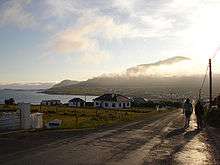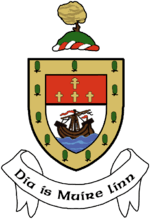Dooagh

Dooagh (Irish: Dumha Acha) is a village located on Achill Island in County Mayo, Ireland. It is best known for the nearby Keem Bay, a Blue Flag beach.
Dooach beach
As of May 2017, Dooach beach has 300 metres of golden sand. Previously, the sand was completely washed away in a storm in 1984, leaving a rocky foreshore that remained until the sand was restored by an unusually high tide in April 2017. The new sandy beach was reported as causing an increase in tourism to the village.[1]
Transport
Road access
Dooagh is located on the R319 regional road.
Public transport
Bus services
Bus Éireann route 440 (Dooagh-Westport-Ireland West Airport Knock) operates once a day in each direction. On Sundays route 440 does not operate however Expressway route 52 provides an evening journey each way to/from Westport and Galway[2]
Rail access
The nearest rail services may be accessed at Westport railway station approximately 62 km away. There are several trains a day from Westport to Dublin Heuston via Athlone.
Facilities
It once had three hotels but these have been closed due to the falling level of tourism in recent times. There are, however, some Bed and breakfast establishments and self-catering apartments. There are two Public houses, Lourdie's and Gielty's Bar and Restaurant which often play host to Traditional Irish Music sessions. The bar and nightclub in the Wavecrest Hotel is open seasonally.
Places of interest
- Going west along the road leads one over the side of Croghaun Mountain to the golden sands of Keem Strand, with impressive views over Clew Bay. A turning off the Keem Road leads to Lough Acorrymore, surrounded by scree slopes and now dammed to supply water for the entire island.[3] The seaward side of Croghaun has spectacularly high cliffs, the island's highest.
- On the road from Dooagh beach towards Lough Corrymore stands an impressive building called Corrymore House, once the home of Captain Charles Boycott,[3] a British land agent whose ostracism by his local community in Ireland as part of a campaign for agrarian tenants' rights in 1880 gave the English language the verb to boycott, meaning "to ostracise". Captain Boycott moved to Corrymore House after his residence at Keem was burnt down. The American artist Robert Henri also lived there at one time,[3] having bought the house in 1924.[4]
Culture
- A proud tradition of the Pipe band thrives on Achill, with the Island having five Pipe bands, Dooagh Pipe Band being one of these. Dooagh Pipe Band was founded on 17 March 1947 with a membership of eleven.[5]
- Scoil Acla, Irish Traditional Music Summer School, takes place annually in Dooagh. In 2008 300 students enrolled. Scoil Acla was established in 1910. Artist Paul Henry was an active member of Scoil Acla and in 1912 directed the play Casadh an t-Sugain (The Twisting Of The Rope) by Douglas Hyde, in the Scoil Acla Hall. The school gradually went into decline, but was revived again in 1985.[6]
Education
- Dooagh National School serves the families of the Dooagh, Pollagh and Keel areas. It has 36 pupils and two teachers. The school was built in 1959 and renovated in 2001.[7]
- Achill Archaeological Field School is based at the Achill Archaeology Centre in Dooagh. It was founded in 1991 and is a training school for students of archaeology and anthropology. Since 1991, several thousand students from 21 countries have come to Achill to study. The school is involved in a study of the prehistoric and historic landscape at Slievemore, incorporating a research excavation at a number of sites within the Deserted Village of Slievemore. Slievemore is rich in archaeological monuments that span a 5000-year period from the Neolithic to the Post Medieval.[8]
People
- Artist Robert Henri came to Achill on a regular basis in the early decades of the 20th century. It was during his early trips to Achill prior to the outbreak of World War I that Henri painted extensively and is reputed to have done portraits of almost all the children in Dooagh village. He bought Corrymore House on the hill above Dooagh in 1924. He died in America in 1929.[4]
Dooagh Day

Each July on the second weekend of the month the village plays host to a festival which includes Traditional Irish Currach Racing, Bouncy Castles, Food, Games, Music, Plastic Duck Race as well as an Historical Exhibition. The first Dooagh Day took place on Sunday 12 July 2015.
See also
References
- ↑ McDonald, Henry (8 May 2017). "Irish beach washed away 33 years ago reappears overnight after freak tide". The Guardian. London. Retrieved 8 May 2017.
- ↑ "Archived copy" (PDF). Archived from the original (PDF) on 18 April 2013. Retrieved 2013-05-05.
- 1 2 3 "Dooagh" (PDF). Achill Tourism. Archived from the original (PDF) on 11 October 2008. Retrieved 7 March 2009.
- 1 2 "Their portraits are famous in America but - Whatever happened to the Commins family of Achill?". Western People - 1 April 1998. Archived from the original on 22 June 2011. Retrieved 7 March 2009.
- ↑ "Dooagh Pipe Band". band website. Retrieved 7 March 2009.
- ↑ "Scoil Acla Irish Traditional Music Summer School". Scoil Acla. Archived from the original on 6 July 2009. Retrieved 7 March 2009.
- ↑ "Dooagh National School". School website. Archived from the original on 5 October 2011. Retrieved 7 March 2009.
- ↑ "Achill Archaeological Field School 2009". Achill Archaeological Field School. Retrieved 7 March 2009.
External links
| Wikimedia Commons has media related to Dooagh. |
Coordinates: 53°58′28.00″N 10°07′47.00″W / 53.9744444°N 10.1297222°W
